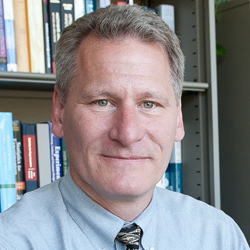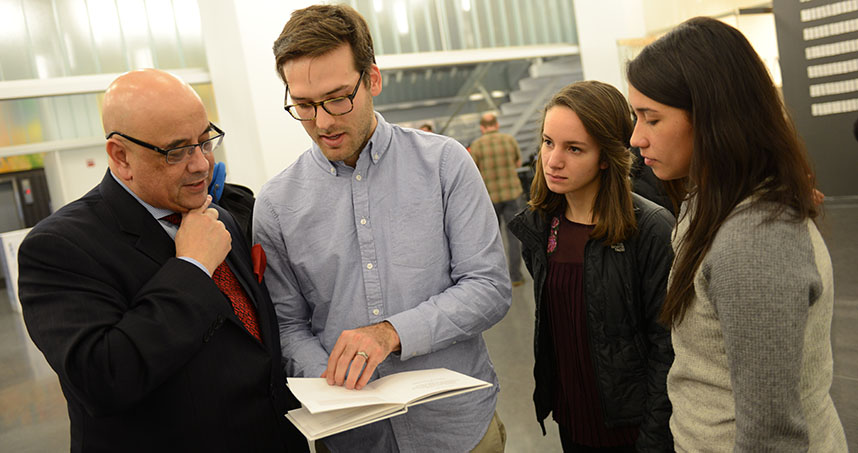Schools Collaborate to Turn Information into Art
In the late hours of Friday, December 28, 2007, a Wikipedia editor named “Unnatural gas” sliced through the entry for global warming, dragging his electronic red pen through the page’s “weasel words.” A mere seconds later, another editor named Brusegadi re-added the deleted words. “Not weasel words,” he typed. “They are from sources.”
Northwestern’s Steph Shapiro, a senior studying design and sociology, and her team sorted through the page’s enormous list of past edits, noting the back and forth debates over even the smallest details.
“Wikipedia editors aren’t researchers,” she said. “So they have their own influences that cause them to change the information. There are many behind-the-scenes debates as editors work toward consensus.”
This evolution of edits served as the basis of [View history], an artistic installation that visually reveals the evolution of Wikipedia’s global warming entry. The piece is one of the four final projects that emerged from the Data Viz Collaborative, a fall course co-taught by faculty from Northwestern University and the School of the Art Institute of Chicago (SAIC). Each interdisciplinary team included students from the McCormick School of Engineering and Applied Science, which organized the collaboration through the Segal Design Institute.
The class's projects were exhibited in “Information as Art," which showed at the SAIC’s LeRoy Neiman Center, 37 S. Wabash Ave, in Chicago through Dec. 15.
 Supported by the Barry and Mary Ann MacLean Fund for Arts and Engineering, the course is in its second year and aims to challenge students from both institutions to work together to translate complicated data sets into visual art or images that an average viewer can understand. Participating Northwestern faculty include Bruce Ankenman, associate professor of industrial engineering and management sciences; Darren Gergle, associate professor of communication studies and computer science; and Bryan Pardo, associate professor computer science and music theory and cognition.
Supported by the Barry and Mary Ann MacLean Fund for Arts and Engineering, the course is in its second year and aims to challenge students from both institutions to work together to translate complicated data sets into visual art or images that an average viewer can understand. Participating Northwestern faculty include Bruce Ankenman, associate professor of industrial engineering and management sciences; Darren Gergle, associate professor of communication studies and computer science; and Bryan Pardo, associate professor computer science and music theory and cognition.
“Originally, we had no idea if this class would work,” said McCormick Dean Julio M. Ottino. “These projects are proof that seemingly diverse populations can work together and accomplish something that would be hard to accomplish in isolation.”
The [View history] team spent 28 hours printing past Wikipedia global warming entries onto sheets of Plexiglas, which were then lined up with the newest entry in front and the oldest in back. A viewer standing in front of the stack can see through the progression of edits, back to pages that have long since been deleted from public knowledge.
“It’s like you are looking back in time,” said Julia Torres, a second year MFA student at the SAIC and part of the [View history] team. “Wikipedia strives to be neutral, but what is the relationship between neutrality and truth? It’s interesting to see how that works out in a collaborative document.”
Another team created an interactive installation called “Un*spoken,” which explores the similarities and differences between laughter and crying. The team translated a database of sounds into music, which was then printed onto strips of paper to be played by a music box. Participants took turns selecting papers of adult or baby laughter or crying and feeding them through the hand-crank boxes to hear the sounds.
“We noticed that you really can’t tell the difference between laughing and crying,” said Megan Pryce, a second-year MFA student at SAIC. “But the baby sounds are definitely more complicated than the adult sounds.”
“None of us have a basic knowledge of the science of sound,” added Yao Shi, a student in McCormick’s Master of Science in Engineering Design and Innovation program. “So we learned a lot about how to do research and then work it into art.”
Wikitropolis investigated the link-system architecture of Wikipedia by examining the entries for five cities: Chicago, London, New York, Paris, and Tokyo. Each city was represented by its own three-dimensional pillar, which was papered with links from its Wikipedia page. The links darkest in color were unique to one particular city while lighter links represented more common features.
“We wanted the pillars to look like both a bar graph and a skyline,” said Paola Lopez, a sophomore at the SAIC. “You can lose yourself in information by clicking through links on Wikipedia; it’s like a rabbit hole.”
Working with Chicago housing data, the Rendered Ghosts team presented an installation showing recent history and ongoing social and political effects of the foreclosure crisis. An interactive monitor displayed the frequency and location of foreclosures in Cook County, including an in-depth look at the Portage Park neighborhood, which has one of the highest foreclosure rates compared to the rest of the city. The project also included a town of 3-D printed houses that were painted in different colors to represent foreclosure statistics.
“People might think that SAIC students are so much more creative,” Torres said. “But McCormick students are just as creative as we are.”
“I usually think about presenting my work for the scientific community,” said Vijay Murganoor, a McCormick graduate student in computer science who worked on Rendered Ghosts. “Now I’ve started thinking in more aesthetic terms rather just in numbers. This class has shown me a new way to present my work that can reach many more people.”
The class also showed all participants that art and engineering students aren’t that different after all. Though they had to overcome some language barriers, they found there were no stereotypical divisions when working together. Northwestern students handled some of the creative work; and the SAIC students often worked with the datasets.
“People might think that SAIC students are so much more creative,” Torres said. “But the McCormick students are just as creative as we are.”



![Visitors look through a book of edits at the [View history] exhibit.](../../../../images/news/2014/12/schools-collaborate-to-turn-information-into-art-s3.jpg)


![Student attendees study the [View history] exhibit.](../../../../images/news/2014/12/schools-collaborate-to-turn-information-into-art-s7.jpg)